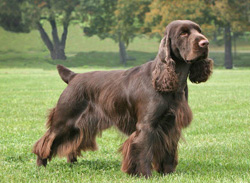Field Spaniels are medium-sized dogs with a single, dense, and water-repellent coat. Their glossy, moderately-long hair can be liver, golden liver, or black in color, and these dogs have feathering on their underbody, chest, buttocks, and the backs of their legs. Their ears are pendulous and moderately long, and their eyes are almond-shaped, dark, and set deep and wide. Field Spaniels measure 17 to 18 inches tall at the shoulder and weigh 35 to 50 pounds.
It is beloved for its affectionate and easy-going personality, and the breed's numbers will likely continue to rise in the United States.
An independent and easygoing breed, Field Spaniels make excellent family companions. They are intelligent, outgoing, affectionate, and active, and they get along with children and other pets. These dogs are best suited to active families, as they need regular exercise and time outdoors.
Field Spaniels are one of the rarest of the spaniel breeds. In fact, until the 1960s, there were no Field Spaniels at all in the United States. Because of this, it may take time to locate one of these dogs for adoption or purchase. Patience is essential.
Field Spaniels are loving, docile, and affectionate dogs that enjoy spending time with their human family members. They are generally reserved around strangers, but they warm up quickly and are not usually shy or timid. These dogs are great with children, although they prefer gentle play, and they get along well with most other pets. Their hunting instincts may pose a threat to pet birds, however.
Happiest when given a job to do, Field Spaniels should not be left alone for long periods or neglected. When bored, they may misbehave or become destructive. These dogs are devoted and sensitive and need a lot of attention and affection from their human family.
Field Spaniels need plenty of exercise and regular opportunities to run, explore, and hunt. If also given free time in securely fenced yard or dog park, a long walk each day is enough to satisfy their need for activity. It's important to keep these dogs on a leash at all times during walks to stop them from chasing every bird or small animal they see or smell.
Field Spaniels are generally healthy dogs, but they are known to suffer from certain health conditions more often than some other breeds. Congenital hip dysplasia, patellar luxation, progressive retinal atrophy, ear infections, and cataracts are all known to affect these dogs. Additionally, Field Spaniels are at increased risk for developing hypothyroidism and retinal dysplasia.
Sadly, Field Spaniels are also prone to subaortic stenosis, an inherited condition that causes the heart to develop abnormally. Subaortic stenosis is usually discovered when a heart murmur is picked up during a standard veterinary examination. This condition can be fatal, but minor cases are usually manageable with professional care.
In the absence of serious genetic diseases, and provided they receive routine veterinary care, timely vaccinations, and proper nutrition, Field Spaniels usually live 12 to 14 years.
Field Spaniels respond best to positive reinforcement, such as play and food rewards, and will shut down under overly strict training or harsh criticism. With the right technique, however, these dogs are highly trainable and learn quickly. Their sensitive natures must be a consideration whenever a training program is being developed.
Patience and consistency are key when training or socializing this breed, as Field Spaniels tend to mature slowly. Teaching these dogs commands is essential before taking them into the field or allowing them to spend time off a leash, as the breed has a natural desire to explore that can lead to trouble.
To keep these dogs happy, healthy, and out of trouble, it's essential to give them chores to complete and to keep them physically busy. In addition to hunting, Field Spaniels are excellent at flyball, tracking, dock diving, agility, and other dog sports. They also enjoy hiking, camping, and other activities.
Field Spaniels are a low-maintenance breed when it comes to grooming. Their medium-length, single coat requires only occasional trimming and weekly brushing. If the feathering becomes tangled, a combing every few days will remove mats and improve the coat's appearance and overall health. Additionally, the hair between the footpads should be trimmed every few weeks.
Field Spaniels shed moderately, but loose hair can be kept to a minimum with increased brushing. Bathing is not necessary unless the Field Spaniel rolls around in something harmful, stinky, or sticky. Using a pH-balanced, canine shampoo will prevent dry skin and irritation and keep the coat shiny and manageable.
The nails need trimming every few weeks, and the ears should be checked weekly for signs of infection. After swimming or bathing, Field Spaniels needs their ears dried to prevent yeast or bacterial infections from developing. The teeth should be brushed daily or a quality dental chew should be used between brushings to prevent tartar build-up and reduce the risk of tooth decay and gum disease.
Originating in England during the mid-1800s, the Field Spaniel was developed to locate, flush, and retrieve birds and small game from both land and water. The breed was created from the Cocker, Sussex, and English Water Spaniels.
Although the Field Spaniel made its way to the United States in the 1880s, it was not recognized as a distinct breed from the Cocker Spaniel until the 20th century. When the two breeds were separated, anything weighing more than 25 pounds became known as the Field Spaniel. After changes to the breed resulted in a decline in hunting ability, the breed nearly became extinct. Breeders worked to bring the breed back, and Field Spaniels were successfully reintroduced in the United States during the mid 1900s.
Today, the breed is primarily a companion animal, and it remains one of the rarest spaniel breeds in America. It is beloved for its affectionate and easy-going personality, and the breed's numbers will likely continue to rise in the United States.
The American Kennel Club officially recognized the Field Spaniel in 1894.

